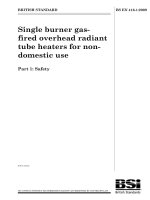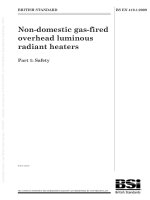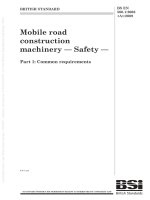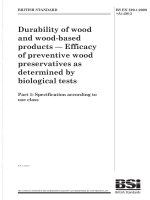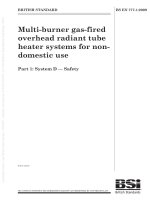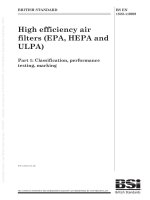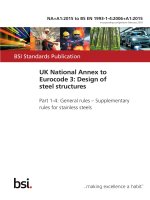Bsi bs en 62137 1 4 2009
Bạn đang xem bản rút gọn của tài liệu. Xem và tải ngay bản đầy đủ của tài liệu tại đây (1.71 MB, 18 trang )
BS EN 62137-1-4:2009
BSI British Standards
Surface mounting technology —
Environmental and endurance
test methods for surface mount
solder joint —
Part 1-4: Cyclic bending test
NO COPYING WITHOUT BSI PERMISSION EXCEPT AS PERMITTED BY COPYRIGHT LAW
raising standards worldwide™
BRITISH STANDARD
BS EN 62137-1-4:2009
National foreword
This British Standard is the UK implementation of EN 62137-1-4:2009. It is
identical to IEC 62137-1-4:2009.
The UK participation in its preparation was entrusted to Technical Committee
EPL/501, Electronic assembly technology.
A list of organizations represented on this committee can be obtained on
request to its secretary.
This publication does not purport to include all the necessary provisions of a
contract. Users are responsible for its correct application.
© BSI 2009
ISBN 978 0 580 59252 2
ICS 31.190
Compliance with a British Standard cannot confer immunity from
legal obligations.
This British Standard was published under the authority of the Standards
Policy and Strategy Committee on 31 March 2009.
Amendments issued since publication
Amd. No.
Date
Text affected
BS EN 62137-1-4:2009
EUROPEAN STANDARD
EN 62137-1-4
NORME EUROPÉENNE
February 2009
EUROPÄISCHE NORM
ICS 31.190
English version
Surface mounting technology Environmental and endurance test methods
for surface mount solder joint Part 1-4: Cyclic bending test
(IEC 62137-1-4:2009)
Technologie de montage en surface Méthodes d'essais d'environnement
et d'endurance des joints brasés
montés en surface Partie 1-4: Essai de flexion cyclique
(CEI 62137-1-4:2009)
Oberflächenmontage-Technik Verfahren zur Prüfung
auf Umgebungseinflüsse
und zur Prüfung der Haltbarkeit
von Oberflächen-Lötverbindungen Teil 1-4: Zyklische Biegeprüfung
(IEC 62137-1-4:2009)
This European Standard was approved by CENELEC on 2009-02-01. CENELEC members are bound to comply
with the CEN/CENELEC Internal Regulations which stipulate the conditions for giving this European Standard
the status of a national standard without any alteration.
Up-to-date lists and bibliographical references concerning such national standards may be obtained on
application to the Central Secretariat or to any CENELEC member.
This European Standard exists in three official versions (English, French, German). A version in any other
language made by translation under the responsibility of a CENELEC member into its own language and notified
to the Central Secretariat has the same status as the official versions.
CENELEC members are the national electrotechnical committees of Austria, Belgium, Bulgaria, Cyprus, the
Czech Republic, Denmark, Estonia, Finland, France, Germany, Greece, Hungary, Iceland, Ireland, Italy, Latvia,
Lithuania, Luxembourg, Malta, the Netherlands, Norway, Poland, Portugal, Romania, Slovakia, Slovenia, Spain,
Sweden, Switzerland and the United Kingdom.
CENELEC
European Committee for Electrotechnical Standardization
Comité Européen de Normalisation Electrotechnique
Europäisches Komitee für Elektrotechnische Normung
Central Secretariat: avenue Marnix 17, B - 1000 Brussels
© 2009 CENELEC -
All rights of exploitation in any form and by any means reserved worldwide for CENELEC members.
Ref. No. EN 62137-1-4:2009 E
BS EN 62137-1-4:2009
EN 62137-1-4:2009
-2-
Foreword
The text of document 91/815/FDIS, future edition 1 of IEC 62137-1-4, prepared by IEC TC 91, Electronics
assembly technology, was submitted to the IEC-CENELEC parallel vote and was approved by CENELEC
as EN 62137-1-4 on 2009-02-01.
The following dates were fixed:
– latest date by which the EN has to be implemented
at national level by publication of an identical
national standard or by endorsement
(dop)
2009-11-01
– latest date by which the national standards conflicting
with the EN have to be withdrawn
(dow)
2012-02-01
Annex ZA has been added by CENELEC.
__________
Endorsement notice
The text of the International Standard IEC 62137-1-4:2009 was approved by CENELEC as a European
Standard without any modification.
__________
BS EN 62137-1-4:2009
-3-
EN 62137-1-4:2009
Annex ZA
(normative)
Normative references to international publications
with their corresponding European publications
The following referenced documents are indispensable for the application of this document. For dated
references, only the edition cited applies. For undated references, the latest edition of the referenced
document (including any amendments) applies.
NOTE When an international publication has been modified by common modifications, indicated by (mod), the relevant EN/HD
applies.
Publication
Year
Title
EN/HD
Year
Environmental testing Part 1: General and guidance
EN 60068-1
1994
2)
Printed board design, manufacture and
assembly - Terms and definitions
EN 60194
2006
2)
IEC 60068-1
-
1)
IEC 60194
-
1)
IEC 61188-5
Series Printed boards and printed board
EN 61188-5
assemblies - Design and use Part 5: Attachment (land/joint) considerations
IEC 61190-1-2
-
1)
Attachment materials for electronic
EN 61190-1-2
assembly Part 1-2: Requirements for soldering paste for
high-quality interconnects in electronics
assembly
2007
IEC 61190-1-3
-
1)
Attachment materials for electronic
EN 61190-1-3
assembly Part 1-3: Requirements for electronic grade
solder alloys and fluxed and non-fluxed solid
solders for electronic soldering applications
2007
2)
IEC 61249-2-7
-
1)
Materials for printed boards and other
EN 61249-2-7
interconnecting structures + corr. September
Part 2-7: Reinforced base materials, clad and
unclad - Epoxide woven E-glass laminated
sheet of defined flammability (vertical burning
test), copper-clad
2002
2005
2)
IEC 61760-1
-
1)
Surface mounting technology EN 61760-1
Part 1: Standard method for the specification
of surface mounting components (SMDs)
2006
2)
1)
Undated reference.
2)
Valid edition at date of issue.
Series
2)
www.bzfxw.com
BS EN 62137-1-4:2009
–2–
62137-1-4 © IEC:2009
CONTENTS
1
Scope ...............................................................................................................................5
2
Normative references .......................................................................................................6
3
Terms and definitions .......................................................................................................6
4
Test equipment and material ............................................................................................6
5
4.1 Test equipment for cyclic bending ...........................................................................6
4.2 Test substrate .........................................................................................................7
4.3 Solder alloy .............................................................................................................7
4.4 Solder paste ............................................................................................................7
4.5 Reflow soldering equipment ....................................................................................7
4.6 Surface mount component for testing ......................................................................7
Mounting method ..............................................................................................................7
6
Test conditions .................................................................................................................8
7
6.1 Pre-treatment ..........................................................................................................8
6.2 Test procedures ......................................................................................................8
6.3 Judging criteria........................................................................................................9
Items to be included in the test report ...............................................................................9
8
Items to be prescribed in the product specifications..........................................................9
Annex A (normative) Cyclic bending test equipment............................................................. 11
www.bzfxw.com
Figure 1 – Image drawing on evaluation area of joint strength.................................................5
Figure 2 – Typical reflow soldering profile ...............................................................................8
Figure A.1 – Sample structure of substrate bending jig ......................................................... 12
Figure A.2 – Sample structure of cyclic bending strength test ............................................... 13
BS EN 62137-1-4:2009
62137-1-4 © IEC:2009
–5–
SURFACE MOUNTING TECHNOLOGY –
ENVIRONMENTAL AND ENDURANCE TEST METHODS
FOR SURFACE MOUNT SOLDER JOINT –
Part 1-4: Cyclic bending test
1
Scope
The test method described in this part of IEC 62137 applies to surface mount components
with a thin and wide basal plane, such as QFP and BGA. This test method evaluates the
endurance of the solder joints between component leads and lands on a substrate by cyclic
bending of substrate.
This test also evaluates the effects of repeated mechanical stress, such as key pushing in cell
phones, the strength of the solder joint between component terminals and lands on a
substrate.
In this test method,
substrate by reflow
until fracture of the
substrate, mounted
the solder joints.
the evaluation requires first to mount the surface mount component on the
soldering, then cyclically bend the substrate to a certain degree of depth
solder joints occurs. The properties of the solder joints (e.g, solder alloy,
device or design, etc.) are evaluated to assist in improving the strength of
www.bzfxw.com
Component
lead
Component lead
Enlarge
Solder
Evaluation area
Plated layers
Intermetallic compound
layers
Substrate
Substrate land
Substrate
Figure 1 – Image drawing on evaluation area of joint strength
IEC 1174/07
BS EN 62137-1-4:2009
–6–
62137-1-4 © IEC:2009
2 Normative references
The following referenced documents are indispensable for the application of this document.
For dated references, only the edition cited applies. For undated references, the latest edition
of the referenced document (including any amendments) applies.
IEC 60068-1, Environmental testing – Part 1: General and guidance
IEC 60194, Printed board design, manufacture and assembly – Terms and definitions
IEC 61188-5 (all parts 5), Printed boards and printed board assemblies – Design and use –
Part 5: Attachment (land-joint) considerations
IEC 61190-1-2, Attachment materials for electronic assembly – Part 1-2: Requirements for
soldering pastes for high-quality interconnects in electronics assembly
IEC 61190-1-3, Attachment materials for electronic assembly – Part 1-3: Requirements for
electronic grade solder alloys and fluxed and non-fluxed solid solders for electronic soldering
applications
IEC 61249-2-7, Materials for printed boards and other interconnecting structures – Part 2-7:
Reinforced base materials clad and unclad – Epoxide woven E-glass laminated sheet of
defined flammability (vertical burning test), copper-clad
www.bzfxw.com
IEC 61760-1, Surface mounting technology – Part 1: Standard method for the specification of
surface mounting components (SMDs)
3 Terms and definitions
For the purposes of this document, the terms and definitions given in IEC 60194, IEC 60068-1
and IEC 61249-2-7 as well as the following apply.
3.1
cyclic bending strength
intensity of the strength, which is expressed in the number of cycles to attain the joint fracture
between surface mount component terminals mounted on the printed board and the copper
land of the substrate after bending the substrate cyclically to a certain degree to allow the
surface of the component side of the board to become a convex shape
3.2
displacement rate
moving velocities of the indenter when cyclically bending the substrate
3.3
displacement range
distance from the initial test position at the centre of the substrate to the maximum indentation
caused by pushing the indenter down and by pulling it back
4 Test equipment and materials
4.1
Test equipment for cyclic bending
The equipment for cyclic bending tests consists of a tension compression testing machine,
substrate bending jigs, a resistance measuring instrument and a recorder. The specifications
shall comply with those of the cyclic bending test equipment described in Annex A.
BS EN 62137-1-4:2009
62137-1-4 © IEC:2009
4.2
–7–
Test substrate
Unless otherwise prescribed by the relevant product specifications, the test substrate shall
meet the following conditions:
a) Material: Epoxide woven, glass fabric, copper-clad laminated sheet, general purpose
grade (see IEC 61249–2-7), with foil bonded to one side and a nominal thickness of the
sheet, including the metal foil, of 1,6 mm with a tolerance of ±0,20 mm. The copper foil
should have a thickness of 0,035 mm ± 0,010 mm.
b) Size: The size of the substrate depends on the size and shape of a surface mount device
soldered on the substrate. The substrate shall be able to be fastened to the pull test
equipment.
c) Land geometry: The shape and size of a land shall comply with the IEC 61188-5 series or
the pad geometry recommended by the respective component supplier.
d) Surface protection: The solderable areas of the substrate (lands) shall be protected
against oxidization by suitable means, for example by an organic surface protection layer
(OSP). This protective layer shall not adversely effect the solderability of the lands under
the soldering conditions of the reflow soldering equipment.
4.3 Solder alloy
Unless otherwise specified, the solder alloy shall consist of a ternary composition of Sn, Ag
and Cu with the Ag content ranking from 3,0 % to 4,0 % by weight and the Cu content ranking
from 0,5 % to 1,0 % by weight with Sn for balance, for example SnAg3,0Cu0,5. The solder
alloy shall be in accordance with IEC 61190-1-3.
4.4
Solder paste
www.bzfxw.com
Unless otherwise stated in the relevant product specifications, solder paste should be chosen
from IEC 61190-1-2. However, the solder to be used shall be the one specified in 4.3 above.
4.5
Reflow soldering equipment
Unless otherwise prescribed by the relevant product specifications, reflow-soldering
equipment should be the one that can realize the temperature profile as shown in Figure 2.
4.6
Surface mount component for testing
Unless otherwise prescribed by the relevant product specifications, the surface mount
component shall have the structure that enables the measurement of electrical resistance (for
example, daisy chain).
NOTE In connecting a daisy chain, care should be given to prevent breaking the wiring pattern, such as by
drawing the wiring pattern forth from a shorter rather than a longer direction of the board.
5 Mounting method
Unless otherwise prescribed by the relevant product specifications, the surface mount
component shall be mounted on the substrate in the following sequence:
a) Apply the solder paste specified in 4.4 to the lands of a test substrate as specified in 4.2,
using a stainless steel mask that has openings of the same size, shape and configuration
as the lands as specified in 4.2 c) with a thickness of 100 μm to 150 μm.
b) Mount the test specimen on the test substrate with the printed solder paste.
c) Perform soldering using the reflow soldering equipment specified in 4.5 and the solder
paste specified in 4.4 under the following conditions: typical temperature profile of reflow
soldering is given in Figure 2 and as proposed in IEC 61760-1; the temperature shall be
measured at the land.
BS EN 62137-1-4:2009
62137-1-4 © IEC:2009
–8–
300
SnAgCu Reflow
250 °C
245 °C
235 °C
220 °C
Temperature °C
250
200
180 °C
Preheating
ca 45 s … 90 s > 220 °C
150 °C
150
Typical
Ramp down rate < 6 k/s
100
Ramp up rate < 3 k/s
50
0
0
30
60
90
120
150
180
210
Time s
240
270
300
330
360
Continous line: typical process (terminal temperaure)
Dotted line: process limits. Bottom process limit (terminal temperature). Upper process limit (top surface temperature)
IEC 1176/07
www.bzfxw.com
Figure 2 – Typical reflow soldering profile
6 Test conditions
6.1 Pre-treatment
Unless otherwise stated in the relevant product specifications, the specimen shall be left
under standard atmospheric conditions, as specified in IEC 60068-1, for 4 h or more.
6.2 Test procedures
Unless otherwise stated in the relevant product specifications, the following procedures
should be followed:
a) Fix the test substrate to the substrate bending jig in the following order:
1) First, solder the lead-wires to the terminals (daisy chain) used for monitoring electrical
resistance on the substrate, and then connect the wires to a momentary interruption
detector.
2) Make sure that the centre of the support jigs is evenly spaced (45 mm ± 0,5 mm) apart
from the centre of the indenter.
3) Mount the substrate on the support jigs with the face down of the surface mount
component side. Adjust the position to allow the indenter to push into the central part
of the substrate.
4) Install anti-displacement jigs at both sides of the substrate, leaving no space between
in order to prevent the indenter from pushing down off the centre of the substrate.
5) Make sure that the indenter is at the centre position by having it in contact with the
substrate.
NOTE To ensure that the indenter is going down to the centre position of the substrate and that the
indenter is in contact with the substrate, keep pushing the substrate until a force of 1 N ± 0,1 N is applied.
b) Displacement rate and allowable displacement range shall be set as follows:
BS EN 62137-1-4:2009
62137-1-4 © IEC:2009
–9–
1) The displacement rate shall be 0,5 mm/s (30 mm/min) which is the moving rate of the
indenter to push the central part of the substrate.
2) Allowable displacement range (maximum bending depth) shall be determined by
conducting preliminary tests for each type of surface mount component and thereby
selecting the conditions in which joint fracture can be initiated with the cyclic number of
several thousands. However, the selection should be limited within 1 mm to 4 mm.
c) Continue cyclic bending strength tests at each level mainly in the selected range until the
electrical resistance-measuring instrument can detect occurrence of electric continuity
interruption in the specimen. Make a record of the number of cycles when fracture occurs.
d) Make analytical observations of the fractured part as needed, verify the fracture mode and
record it.
6.3 Judging criteria
When a momentary interruption detector can detect that electrical continuity interruption has
occurred in the specimen, this is judged as a failure.
7 Items to be included in the test report
When a test report is required, agreement shall be made between the reporting party and the
recipient on the selection of reporting items from the following:
a) Test date
b) Location of the test organization
c) Name of the electronic component, type, size, body dimensions and lead pitch
www.bzfxw.com
d) Base materials of lead on electronic components; with or without plating, and materials of
plating
e) Materials of the test substrate, dimensions and layer structure
f)
Measurements of the land on the substrate and materials for the surface treatment
g) Type of solder and type of solder paste
h) Temperature profile of reflow soldering and soldering ambience (for the case of a nitrogen
ambient atmosphere, oxygen concentration should apply)
i)
Model of the tensile and compression machine
j)
Details of the substrate bending jig (drawing is preferable.)
k) Specifications of the electrical resistance-measuring instrument
l)
Specifications of the recorder
m) Displacement rate
n) Displacement range and the number of cycles to fracture initiation
o) Fracture mode (photos, etc.)
NOTE
Solder joint geometry may affect the performance in this test.
8 Items to be given in the product specifications
The following items shall be included:
a) Test substrate (4.2)
b) Solder alloy (4.3)
c) Solder paste (4.4)
d) Reflow soldering equipment (4.5)
e) Specimens (4.6)
BS EN 62137-1-4:2009
– 10 –
f)
62137-1-4 © IEC:2009
Mounting method (5.1)
g) Pre-treatment (6.1)
h) Test procedures (6.2)
www.bzfxw.com
BS EN 62137-1-4:2009
62137-1-4 © IEC:2009
– 11 –
Annex A
(normative)
Cyclic bending test equipment
A.1
Application
Annex A applies to the test equipment for substrate bending strength specified in 4.1 and
specifies the requirements.
A.2
Cyclic bending test equipment
Unless otherwise specified by the relevant product specifications, the cyclic bending test
machine should be able to meet the following requirements.
A.2.1
Tension compression testing machine
The machine shall have the following characteristics:
a) It shall be capable of pushing the indenter to the prescribed displacement (0,5 mm to
5 mm) with the use of triangular waves at the prescribed speed (0,5 mm/s) and after this,
pulling the indenter back to the initial position at the same speed. This test machine also
needs the capability of repeating this activity. Precision of displacement measurement
should be ±1 % of the indication on the test machine (set values) and cyclic precision
should be ±2 %.
www.bzfxw.com
NOTE As the test is effective with sine waves in place of triangular waves, the test machine should also be
able to function with sine waves.
b) The test machine should be able to measure elapsed time and the forces applied to the
test substrate in the course of testing.
c) The test machine should be able to shut down when receiving signals from the electrical
resistance-measuring instrument.
A.2.2
Substrate bending jig
The substrate bending jigs should be able to support the substrate with the face down of the
component side of the printed circuit board, push the centre of the substrate down with the
indenter, and then pull the indenter back. Unless otherwise specified by the relevant product
specifications, these jigs shall meet the following conditions:
The structure shall be as indicated in Figure A.1.
BS EN 62137-1-4:2009
62137-1-4 © IEC:2009
– 12 –
Indenter
Substrate
Support
tool
Support jig (flex ble clamp
for printed wiring boards)
IEC 2235/08
www.bzfxw.com
Figure A.1 – Sample structure of substrate bending jig
a) Material: Steel
NOTE
Steel of high strength is recommended to prevent deformation due to application of cyclic bending .
b) Indenter
The indenter has a radius of 3 mm ± 0,2 mm with the structure that can clip the central part of
the substrate from front to back on both sides. This structure shall prevent the substrate from
distorting after a certain time in the direction that the indenter pushes during the cyclic
bending test; it shall also be able to pull the substrate back to the initial test position.
c) Support jig
The support jig has a radius of 3 mm ± 0,2 mm. Its structure shall be such that both ends of
the substrate can be clipped from front to back on both sides to pull the substrate back to the
initial test position. However, it should not be too tightly constrained, in that it uses head
knocking type rollers on the upper side (see Figure A.1).
d) The distance between the support jigs is 90 mm ± 1 mm.
e) The displacement range (distance between the initial position of the substrate and the
lowest position of the substrate).
Displacement range is 0,5 mm to 5 mm and the test machine needs to have the structure
to function under this condition.
A.2.3
Electrical resistance measuring instrument
The electrical resistance measuring instrument should have the mechanism to verify electrical
continuity and discontinuity on the test substrate and to be able to judge an interruption when
the resistance value exceeds 1 × 10 3 Ω. In order to detect even the minutest electrical
discontinuity, a desirable instrument is the one that can detect momentary continuity
interruption of 10 μs to 100 μs. This instrument should have the ability to output signals so as
to shut down the tension-compression testing machine when electrical interruption is detected.
BS EN 62137-1-4:2009
62137-1-4 © IEC:2009
A.2.4
– 13 –
Recorder
The recorder is the piece of equipment that records the number of cycles that causes
electrical continuity interruption on the substrate. It is desirable that the equipment records
the displacement and the force of the test machine while the test lasts.
Test machine
Repeat displacement
Stop signal
Jig and substrate
Record displacement
and force
Recorder
Electrical resistance
measurement
Electrical resistance
measuring instrument
Record number
of cycles
IEC 2236/08
Figure A.2 – Sample structure of cyclic bending strength test
___________
www.bzfxw.com
www.bzfxw.com
This page deliberately left blank
www.bzfxw.com
This page deliberately left blank
British Standards Institution (BSI)
BSI is the independent national body responsible for preparing British Standards.
It presents the UK view on standards in Europe and at the international level.
It is incorporated by Royal Charter.
Revisions
Information on standards
British Standards are updated by amendment or revision. Users of British
Standards should make sure that they possess the latest amendments or
editions.
It is the constant aim of BSI to improve the quality of our products and
services. We would be grateful if anyone finding an inaccuracy or
ambiguity while using this British Standard would inform the Secretary of
the technical committee responsible, the identity of which can be found
on the inside front cover.
Tel: +44 (0)20 8996 9000 Fax: +44 (0)20 8996 7400
BSI offers members an individual updating service called PLUS which
ensures that subscribers automatically receive the latest editions of
standards.
BSI provides a wide range of information on national, European and
international standards through its Library.
Various BSI electronic information services are also available which give
details on all its products and services. Contact the Information Centre.
Tel: +44 (0)20 8996 7111
Fax: +44 (0)20 8996 7048 Email:
Subscribing members of BSI are kept up to date with standards
developments and receive substantial discounts on the purchase price
of standards. For details of these and other benefits contact Membership
Administration.
Tel: +44 (0)20 8996 7002 Fax: +44 (0)20 8996 7001
Email:
Information regarding online access to British Standards via British
Standards Online can be found at www.bsigroup.com/BSOL
Further information about BSI is available on the BSI website at
www.bsigroup.com
Buying standards
Orders for all BSI, international and foreign standards publications
should be addressed to BSI Customer Services.
Tel: +44 (0)20 8996 9001 Fax: +44 (0)20 8996 7001
Email:
You may also buy directly using a debit/credit card from the BSI Shop
on the website www.bsigroup.com/shop
In response to orders for international standards, it is BSI policy to
supply the BSI implementation of those that have been published
as British Standards, unless otherwise requested.
www.bzfxw.com
Copyright
Copyright subsists in all BSI publications. BSI also holds the copyright, in the UK, of the
publications of the international standardization bodies. Except as permitted under the
Copyright, Designs and Patents Act 1988 no extract may be reproduced, stored in a retrieval
system or transmitted in any form or by any means – electronic, photocopying, recording or
otherwise – without prior written permission from BSI.
This does not preclude the free use, in the course of implementing the standard of necessary
details such as symbols, and size, type or grade designations. If these details are to be used for
any other purpose than implementation then the prior written permission of BSI must be
obtained. Details and advice can be obtained from the Copyright & Licensing Manager.
Tel: +44 (0)20 8996 7070 Email:
BSI Group Headquarters
389 Chiswick High Road London W4 4AL UK
Tel +44 (0)20 8996 9001
Fax +44 (0)20 8996 7001
www.bsigroup.com/standards
raising standards worldwide™
